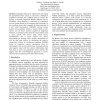Free Online Productivity Tools
i2Speak
i2Symbol
i2OCR
iTex2Img
iWeb2Print
iWeb2Shot
i2Type
iPdf2Split
iPdf2Merge
i2Bopomofo
i2Arabic
i2Style
i2Image
i2PDF
iLatex2Rtf
Sci2ools
ICRA
2002
IEEE
2002
IEEE
A Neural Approach to Adaptive Behavior and Multi-Sensor Action Selection in a Mobile Device
Sampling multisensory information and taking the appropriate motor action is critical for a biological organism’s survival, but a difficult task for robots. We present a Neurally Organized Mobile Adaptive Device (NOMAD), whose behavior is controlled by a simulated nervous system based on the anatomy and physiology of the vertebrate brain, that is capable of action selection in a real world environment. NOMAD’s nervous system consists of an auditory system, a visual system, a taste system, sets of motor neurons capable of triggering behavior, a tracking system driven by visual stimuli, and a value system. The device itself, which moves autonomously, has a CCD camera for vision, microphones for hearing, and a gripper manipulator to pick up and taste objects by measuring the object’s conductivity. Similar to a biological organism, NOMAD learns to categorize sensory information from its environment with no prior instruction, associate positive and negative value with this sensory inf...
Related Content
| Added | 15 Jul 2010 |
| Updated | 15 Jul 2010 |
| Type | Conference |
| Year | 2002 |
| Where | ICRA |
| Authors | Jeffrey L. Krichmar, James A. Snook |
Comments (0)

